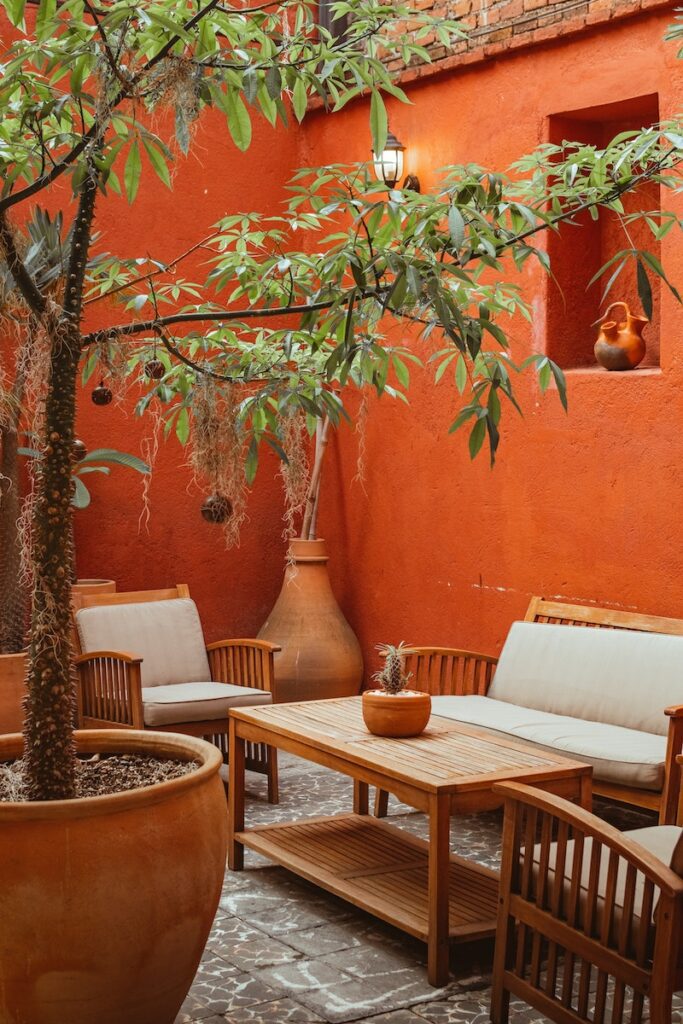Do you know how to tell if outdoor furniture is teak? Keep reading to learn how to identify genuine teak outdoor furniture with confidence. Learn about key characteristics, visual cues, and expert tips to determine if your furniture is made of high-quality teak wood.
Teak is a highly sought-after wood known for its durability, beauty, and resistance to weathering. However, not all outdoor furniture claiming to be teak is genuine. In this guide, we will walk you through the essential factors to consider and the telltale signs that can help you determine if your furniture is truly made of teak. By the end, you’ll be equipped with the knowledge and confidence to make an informed decision when purchasing or identifying teak outdoor furniture.
Understanding teak wood
Contents
- 1 Understanding teak wood
- 2 How to tell if outdoor furniture is teak
- 3 What are the color variations in teak outdoor furniture?
- 4 How to distinguish between teak and synthetic materials in outdoor furniture?
- 5 FAQs about how to tell if outdoor furniture is teak
- 6 Final remarks on how to tell if outdoor furniture is teak
Before we delve into the methods of identifying teak outdoor furniture, let’s familiarize ourselves with the characteristics of teak wood:
-
Origin and Availability:
- Teak wood originates from the Tectona grandis tree, native to Southeast Asia.
- Genuine teak furniture is often sourced from countries like Indonesia, Myanmar (Burma), and Thailand.
- Teak has been used for centuries in shipbuilding and outdoor furniture due to its natural resistance to rot and decay.
-
Natural Properties of Teak Wood:
- Teak is a hardwood with a high oil content, making it highly resistant to moisture, insects, and fungal decay.
- It has a tight grain pattern and a rich, golden-brown color when freshly cut, which weathers to a silvery gray patina over time.
- Teak wood is renowned for its strength, stability, and longevity, making it ideal for outdoor applications.
How to tell if outdoor furniture is teak
Now that we understand the basics of teak wood, let’s explore the methods to determine if your outdoor furniture is truly made of teak:
1. Visual Inspection
Teak outdoor furniture possesses distinct visual characteristics that can help you identify its authenticity:
-
Grain Pattern and Texture:
- Teak wood has a straight, even grain pattern that is typically tight and smooth to the touch.
- Look for a fine, consistent texture with minimal knots or irregularities.
-
Color and Aging:
- Freshly cut teak has a warm, honey-brown color, which gradually matures into a silver-gray patina when exposed to the elements.
- Genuine teak furniture showcases this natural color transformation over time.
-
Weight:
- Teak is a dense hardwood, so teak furniture tends to be heavier than furniture made from other materials.
- Lift the piece and assess its weight. Authentic teak furniture will feel substantial and solid.
2. Sourcing and Documentation
Examining the origin and documentation of the furniture can provide valuable insights into its authenticity:
-
Country of Origin:
- Teak wood is primarily sourced from Southeast Asia, especially Indonesia, Myanmar (Burma), and Thailand.
- Furniture manufactured in these regions has a higher likelihood of being made from genuine teak.
-
Certification and Labels:
- Look for certifications or labels that indicate the furniture is made from sustainably harvested teak, such as the Forest Stewardship Council (FSC) certification.
- Authentic teak furniture manufacturers often provide documentation or labels verifying the teak wood used.
-
Manufacturer Reputation:
- Research the manufacturer or retailer of the furniture. Reputable brands known for producing high-quality teak furniture are more likely to deliver authentic products.
What are the color variations in teak outdoor furniture?
Teak outdoor furniture is renowned for its natural beauty and distinctive color variations. The color of teak furniture can vary widely, and understanding these variations can help you choose the perfect piece for your outdoor space. Here are two paragraphs that delve into the color variations of teak outdoor furniture:
Teak furniture starts with a warm honey or golden hue when it is freshly cut and untreated. Over time, exposure to the elements, such as sunlight and rain, causes the wood to undergo a beautiful transformation. One of the remarkable characteristics of teak is its ability to develop a silvery gray patina as it weathers.
This weathered gray color adds a touch of elegance and sophistication to the furniture, giving it a rustic charm that many people adore. The weathered look is especially popular in coastal or rustic-themed outdoor settings, as it blends seamlessly with the natural surroundings.
However, it’s essential to note that not all teak furniture will naturally develop a gray patina. Some owners prefer to maintain the original golden hue of teak by applying protective sealants or regular oiling to prevent the natural weathering process.
In addition to the classic golden and weathered gray shades, teak outdoor furniture can exhibit other color variations. Some pieces may have streaks or patches of darker brown or reddish-brown tones, known as “mottling.” This mottling occurs due to variations in the wood’s natural pigmentation and adds character and uniqueness to each piece of furniture.
The intensity and distribution of these darker shades can vary, creating a visually appealing contrast against the lighter background. When selecting teak furniture, you can choose from various color variations, depending on your personal preference and the desired aesthetic for your outdoor space.
Whether you prefer the warm golden glow, the weathered silver-gray patina, or the intricate mottling patterns, teak offers a wide range of color options to suit any style or design scheme.
How to distinguish between teak and synthetic materials in outdoor furniture?
When shopping for outdoor furniture, it’s crucial to be able to differentiate between genuine teak and synthetic materials that may mimic its appearance. Here are two paragraphs that provide guidance on distinguishing between teak and synthetic materials in outdoor furniture:
- Look closely at the grain: Teak has a distinct grain pattern that is visible on the surface of the wood. Genuine teak has a straight grain that runs parallel to the length of the boards, with occasional small knots and irregularities. Synthetic materials, on the other hand, often have a uniform and artificial grain pattern that repeats evenly across the surface. The grain in synthetic materials may appear too perfect and consistent, lacking the natural variations and imperfections of real teak.
- Check the weight and feel: Teak is a dense and heavy wood, so authentic teak furniture will have a substantial weight to it. When you pick up a piece of teak furniture, it should feel solid and sturdy. Synthetic materials, on the contrary, are typically lighter and may feel less substantial. Additionally, running your hand along the surface of teak furniture will reveal a smooth, tactile feel, while synthetic materials may have a slightly artificial texture or a plasticky feel.
By examining the grain pattern and considering the weight and feel of the furniture, you can distinguish between genuine teak and synthetic materials. Remember, authentic teak carries a sense of durability, a beautiful natural grain, and a substantial weight, ensuring you invest in high-quality and long-lasting outdoor furniture.
FAQs about how to tell if outdoor furniture is teak
Q: Can teak furniture be painted or stained?
A: Yes, teak furniture can be painted or stained if you prefer a different look or want to protect the wood. However, it is essential to note that painting or staining teak will alter its natural beauty and may require regular maintenance to ensure longevity. If you choose to paint or stain your teak furniture, follow these guidelines:
- Prepare the surface: Clean the furniture thoroughly and remove any existing finishes or coatings before applying paint or stain. Sanding may be necessary to create a smooth surface.
- Choose the right products: Select paint or stain specifically designed for outdoor use and suitable for hardwoods like teak. Ensure the products are compatible with the outdoor environment and provide protection against UV rays and moisture.
- Follow the instructions: Read and follow the manufacturer’s instructions for application, drying time, and number of coats needed. Apply the paint or stain evenly and allow sufficient drying time between coats.
- Seal the finish: Once the paint or stain has dried completely, consider applying a clear sealant or outdoor varnish to protect the surface and enhance durability. Follow the manufacturer’s instructions for the sealant application.
It’s important to note that painting or staining teak furniture is a personal choice, and many people prefer to embrace its natural aging process and unique patina over time. If you decide to maintain the original teak appearance, regular cleaning and occasional application of teak oil or sealer can help preserve its natural beauty and protect it from environmental factors.
Final remarks on how to tell if outdoor furniture is teak
Now you know how to tell if outdoor furniture is teak, identifying genuine teak should be much easier. Learning about outdoor furniture requires a combination of visual inspection, understanding the characteristics of teak wood, and considering factors such as sourcing, documentation, and reputation.
By paying attention to grain patterns, color transformations, weight, country of origin, certifications, and manufacturer information, you can make an informed assessment of whether your furniture is made of teak or not.






